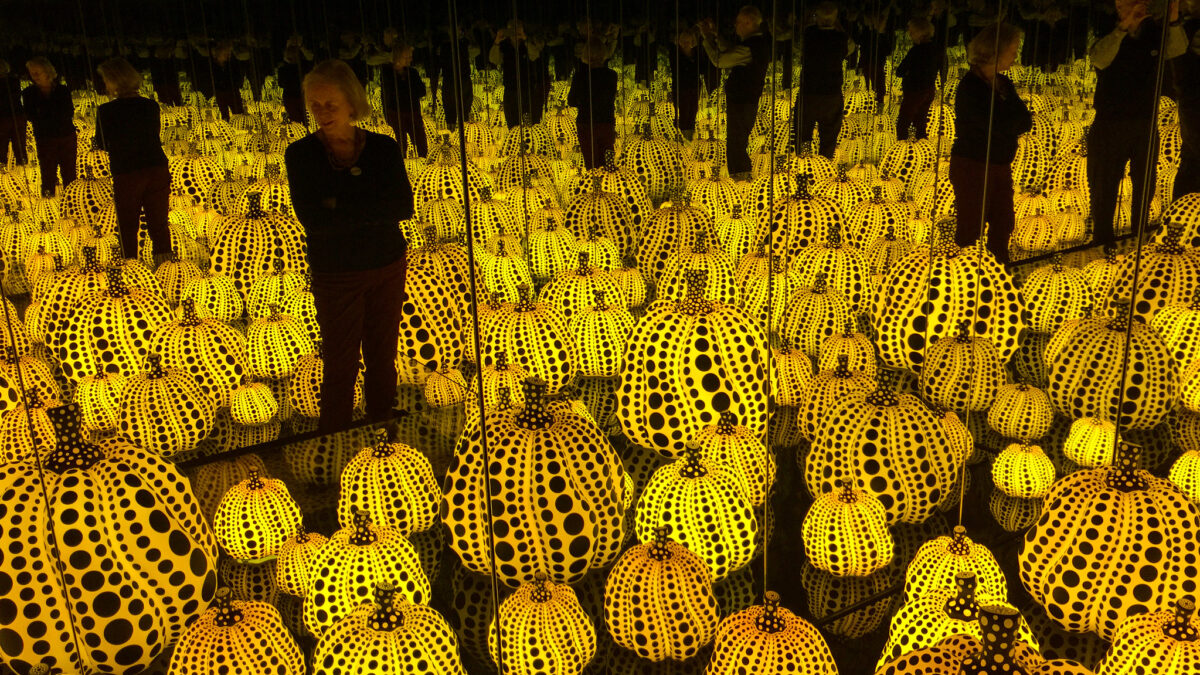“Is this the line for the narcissism exhibit?” That thought crossed my mind on more than one occasion as I snaked through a series of queues outside the Hirshhorn Museum one recent morning. I wanted to see a new exhibit by Japanese artist Yayoi Kusama, coming but five years after her last display at the Hirshhorn.
On second thought, I didn’t want to see the exhibit, so much as I felt compelled to walk through its galleries before writing my critique. Experiencing the most recent showing didn’t change my opinion: Kusama has “Kardashian-ized” the art world.
Appeal to Vanity
One question about the show seems obvious: Why would a gallery put on the second major exhibition of an artist’s work in five years? Artists such as van Gogh, Rembrandt, or Picasso don’t warrant such frequent exhibitions from institutions like the National Gallery of Art, so why has the Hirshhorn hosted another Kusama show?
Before answering that question, consider some of the other exhibits currently on view in the nation’s capital, starting with two Hirshhorn shows featuring artists profiled in recent years on “60 Minutes.” Laurie Anderson works at the intersection of media and memory, using video and other non-traditional techniques as part of her storytelling methods. Mark Bradford’s work “Pickett’s Charge,” a modified and mutilated version of a 19th-century cyclorama portrait depicting the Battle of Gettysburg, prompts questions of the meanings of history — who writes it and how.
Across the National Mall from the Hirshhorn, the National Gallery recently opened a major exhibition from Sao Paolo, Brazil, examining the cultural and historical impact of the African diaspora throughout the Americas. All these exhibits have attracted the attention of art critics, and raise important questions regarding our society, culture, and history.
But none of these major exhibits require timed passes for admittance or generate the types of lines I witnessed to get into Kusama’s shows, both in 2017 and this year’s. All of this likely explains why the Hirshhorn, whose membership rolls grew fivefold during the first show, as people paid for membership to jump the in-person ticket queue, went back to the financial well again by hosting another Kusama exhibit.
Faustian Bargain
But in many respects, the Hirshhorn has made a deal with the devil, selling out to the most vapid and insipid of tastes in another attempt to fill its coffers. The show features but five works, with most attention focused on three, each of which takes up its own room. The “Pumpkin” room features a large sculpture of a yellow and black polka-dotted gourd, surrounded by yellow and black polka-dotted walls.
The two other centerpieces of the exhibit consist of “infinity rooms,” mirrored chambers in which guests enter for a brief period. One room, entitled “Phalli’s Field,” features a floor covered with red and white polka-dotted phallic sculptures. The second, Kusama’s newest infinity room, contains a series of polka-dotted lanterns that change colors as guests walk through.
While bright and colorful, and of a time and genre consistent with the Hirshhorn’s focus on modern art, Kusama’s work fails to prompt a search for larger meaning. Viewers may enjoy the bright colors and patterns — or not — but will find little opportunity, or invitation, to ponder important social themes or cultural constructs.
If at its best art provides spiritual nourishment for one’s mind, Kusama provides visitors with little more than a superficial sugar high. Then again, most guests don’t visit a Kusama exhibit to focus on others.
Selfie Mania
Kusama’s use of the infinity rooms as her artistic signature seems particularly ironic. She may hope that observers use the mirrors to gaze out into the world beyond — “Become part of your environment. Forget yourself,” a 1968 Kusama quote at the exhibition’s entrance advises — but most viewers use them to look back at themselves.
Hence the phenomenon during the last exhibit, of the ubiquitous selfies advertising one’s presence — the better to post on one’s social media accounts. During the 2017 Hirshhorn exhibit, one art blog noted that “two things are closely associated with … Kusama: pumpkins and selfies.” The two combined for a comedy of errors in February 2017, when a viewer fell during a selfie attempt gone awry, damaging a pumpkin sculpture in one of the infinity rooms on display that year.
Rather than employing art as a medium to examine social trends, or man’s place in the universe, many, if not most, visitors to the Kusama exhibit will use it primarily as an opportunity for self-promotion. The comparisons to the Kardashians seem obvious, from the superficiality and self-absorption to the obsession with social media and attaining status as an “influencer.”
Then again, it’s difficult to blame guests to the Hirshhorn for their narcissistic tendencies. If the Kardashians themselves could recently go through jury selection in a Los Angeles courtroom unfazed by the insults potential jurors threw their way, why should we expect the average tourist visiting a Kardashian-like exhibit to focus on anything other than himself?
Focus on Provoking Thought
As my colleague, William Newton told me, “We are supposed to see ourselves in art, but taking that literally is an entirely narcissistic affair.”
At its best, art should prompt some type of thought — whether understanding the artist and his or her surroundings, contemplating a different place or culture, or exploring abstract concepts like time and being. Even the wokest exhibit qualifies on this front, if for no other reason than by evoking frustration at the way leftist artists and curators can use their work to indoctrinate others.
But don’t expect any of those types of feelings or emotions to come from Kusama at the Hirshhorn. If you’re thinking of getting in the line to take some selfies, just don’t.









